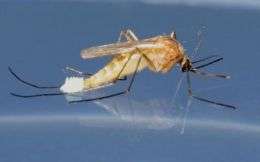No more big stink: scent lures mosquitoes, but humans can't smell it

Mosquito traps that reek like latrines may be no more. A University of California, Davis research team led by chemical ecologist Walter Leal has discovered a low-cost, easy-to-prepare attractant that lures blood-fed mosquitoes without making humans hold their noses.
The synthetic mixture, containing compounds trimethylamine and nonanal in low doses, is just as enticing to Culex mosquitoes as the current attractants, Leal said, but this one is odorless to humans.
The research, published in the current edition of the Public Library of Science Journal or PLOS One, could play a key role in surveillance and control programs for Culex species, which transmit such diseases as West Nile virus, encephalitis and lymphatic filariasis.
Oviposition or gravid female traps draw blood-fed mosquitoes ready to lay their eggs, but the chemical- and water-infused traps just plain stink, Leal said. The smell is highly offensive to those monitoring the traps and to people living near them.
That prompted the UC Davis researchers to launch a multidisciplinary approach to find more user-friendly, chemically based lures for gravid Culex mosquitoes.
Their extensive field research in Recife, Brazil, a region known for its high populations of Culex quiquefasciatus, showed that a combination of trimethylamine and nonanal "is equivalent to the currently used infusion-based lure," Leal said, "and superior in that the offensive smell of infusions was eliminated."
The Leal lab searches for attractants in two ways. The first is the conventional chemical ecology approach or finding smells that attract mosquitoes. The second, or what Leal has coined "reverse chemical ecology," involves studying olfaction after identifying attractants.
Mosquito populations are typically monitored with two traps: the conventional carbon dioxide traps and the gravid female trap. Mosquitoes captured in the carbon dioxide traps are less likely to be infected than those in the gravid traps.
"The gravid traps are more important for surveillance," Leal said, "as they capture mosquitoes that have had a blood meal and thus, more opportunity to become infected."
By monitoring gravid traps containing West Nile virus-infected mosquitoes, mosquito and vector control districts and health officials can determine when it is time to spray.
Leal said that another advantage of the gravid traps is that with the capture of one female mosquito, that eliminates not only her, but hundreds of her would-be offspring. "Each female mosquito has the potential to produce about 200 eggs, and she can have as many as five cycles. So when we capture a gravid mosquito, that can remove as many as 500 females."
UC Davis research entomologist William Reisen said sampling Culex species in urban environments can be challenging, but the gravid trap work is crucial.
Because the Southern house mosquito, Culex quinquefasciatus, feeds on the blood of a wide variety of hosts, the West Nile virus can move rapidly through bird and human populations, according to Reisen.
"Sampling the species in urban environments has been a challenge until studies on its oviposition cues allowed the development of gravid female traps that collect mostly females that previously have blood-fed and, therefore, had a chance to become infected," Reisen.
Leal said the compounds used in the research are "simple and inexpensive" and would be of great benefit "to not only us, but third-world countries where Culex quinquefasciatus is a problem."
The researchers began preliminary field tests in Davis and Sacramento but when aerial sprays mitigated the levels of West Nile virus-infested mosquitoes, they set up traps in Recife, Brazil, a city endemic for lymphatic filariasis.
Source: University of California















